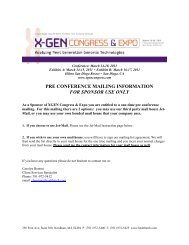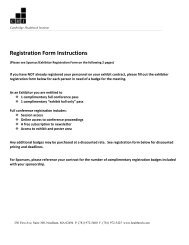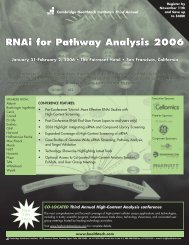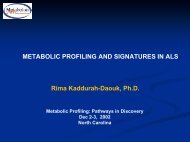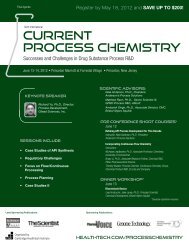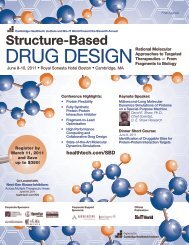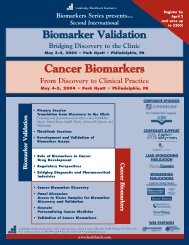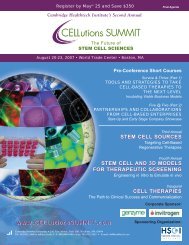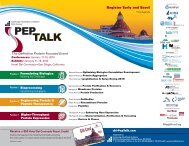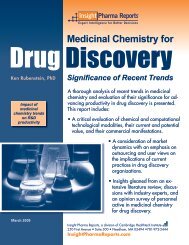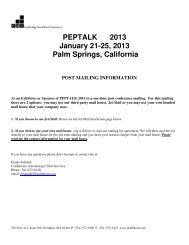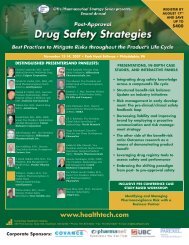2013 Applying Next Generation Sequencing Brochure.pdf
2013 Applying Next Generation Sequencing Brochure.pdf
2013 Applying Next Generation Sequencing Brochure.pdf
You also want an ePaper? Increase the reach of your titles
YUMPU automatically turns print PDFs into web optimized ePapers that Google loves.
Cover<br />
Conference-at-a-Glance<br />
Short Courses/Plenary Keynote<br />
<strong>Sequencing</strong> Strategies for Success<br />
Dynamics of the Microbiome<br />
on Health and Disease<br />
Single-Cell <strong>Sequencing</strong><br />
<strong>Sequencing</strong> Data Analysis<br />
and Interpretation<br />
Sponsor & Exhibit Opportunities<br />
Hotel & Travel Information<br />
Registration Information<br />
Click Here to<br />
Register Online!<br />
Healthtech.com/<strong>Sequencing</strong><br />
Register by<br />
July 12<br />
and Save up<br />
to $250<br />
Cambridge Healthtech Institute<br />
250 First Avenue, Suite 300<br />
Needham, MA 02494<br />
www.healthtech.com<br />
Sixth Annual<br />
August 20-21, <strong>2013</strong><br />
NG X <strong>Sequencing</strong> Data Analysis<br />
and Interpretation Progress in the Pipeline<br />
<strong>Sequencing</strong> a genome is only the beginning. Several layers of analysis are necessary to convert raw sequence data into an understanding<br />
of functional biology. First, error sources in the original raw data from multiple platforms and diverse applications must be accounted for.<br />
Then, as computational methods for assembly, alignment, and variation detection continue to advance, a broad range of genetic analysis<br />
applications including comparative genomics, high-throughput polymorphism detection, analysis of coding and non-coding RNAs, and<br />
identifying mutant genes in disease pathways can be addressed. CHI’s <strong>Sequencing</strong> Data Analysis and Interpretation conference combines<br />
unique perspectives from a variety of researchers, engineers, biostatisticians, and software developers involved in NGS data analysis.<br />
Tuesday, August 20<br />
12:00 pm Main Conference Registration<br />
Sponsored by<br />
12:30 From Reads to Variants: Ten-Fold Reduction in Time<br />
and Cost with Improved Accuracy<br />
Rupert Yip, Ph.D., Director, Product Marketing, Bina Technologies<br />
Alignment and variant calling of raw NGS reads has been plagued by expensive HPC<br />
hardware and the bioinformatics personnel to support and maintain home-grown, opensource<br />
secondary analysis solutions. Such solutions can take up to weeks and $1000s per<br />
analysis. We present a genomic analysis platform that reduces, by ten-fold, the time and<br />
cost for secondary analysis while improving accuracy compared to standard pipelines. Our<br />
innovative model reduces costs by ten-fold while preventing hardware obsolescence.<br />
Tuesday, August 20<br />
»»<br />
Plenary Keynote Session<br />
2:00 Chairperson’s Opening Remarks<br />
Toby Bloom, Ph.D., Deputy Scientific Director, Informatics, New York Genome Center<br />
2:10 A Revolution in DNA <strong>Sequencing</strong> Technologies: Challenges<br />
and Opportunities<br />
Jeffery A. Schloss, Ph.D., Director, Division of Genome Sciences, National Human Genome<br />
Research Institute, National Institutes of Health<br />
The initial sequencing of the human genome spurred an appetite for much more human<br />
sequence information to better understand the contributions of human sequence variation to<br />
health and disease. However, despite dramatic reductions during the Human Genome Project,<br />
13<br />
the cost of sequencing was clearly too high to collect the very large numbers of human<br />
and numerous other organism genome sequences needed to achieve that understanding.<br />
In 2004, NHGRI launched parallel programs to reduce the cost of sequencing a mammalian<br />
genome initially by two (in five years), and eventually by four orders of magnitude (in ten<br />
years). This presentation will summarize the technologies that are in high-throughput use<br />
to produce stunning amounts of sequence and related data and novel biological insights,<br />
and will emphasize technologies currently emerging and on the horizon that may provide<br />
human genome sequence data with the nature, quality, cost and turnaround time needed for<br />
applications in research and medicine.<br />
PRESENT YOUR RESEARCH<br />
Gain further exposure by presenting your work in the poster<br />
sessions. To secure a poster board and inclusion in the conference<br />
materials, your abstract must be submitted, approved and your<br />
registration paid in full by July 12, <strong>2013</strong>.<br />
Reasons you should present your research poster at this conference:<br />
• Your poster will be exposed to our international delegation.<br />
• Receive $50 off your registration.<br />
• Your poster abstract will be published in our conference materials.<br />
• Your research will be seen by leaders from top pharmaceutical, biotech,<br />
academic and government institutes.<br />
>>



